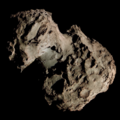The comet brightened slowly at on 14 March 2001 its magnitude was estimated to be 13.1. [8] However in late March 2001 the comet experienced an outburst, brightening from about magnitude 10.8 on 28 March to a magnitude of 8 on 30 March. [9] In mid April the comet was estimated to have a magnitude of about 7.5, while on 18 April, it had brightened to a magnitude of 7, [10] and by the end of the month its magnitude was estimated to be about 6.3. [11]
Fragmentation events
Carl W. Hergenrother, Matthew A. Chamberlain, and Y. Chamberlain, of the Lunar and Planetary Laboratory reported the discovery of a double nucleus in images obtained on 30 April 2001. The two nuclei were of equal brightness and separated by 3.5 arcseconds. [11] Zdenek Sekanina calculated that the splitting occurred on Mar. 29.9 ± 1.6 UT, when the outburst was observed. [12]
Images obtained by the 8.2-metre VLT MELIPAL telescope at ESO's Paranal Observatory on 14 May 2001 revealed that nucleus B was elongated. The comet was imaged again two days, and it was obvious that nucleus B had split in two pieces separated by about one arcsecond. [13] [14] The total magnitude of the comet was then estimated to be 5.4. [15] An ion tail about 4 degree long was observed with 25×100 binoculars. [12] Fragment A was last detected on 19 May. [16] One more fragment, named fragment G, was found in images obtained on 21 May, having its own tail. It probably was separated by fragment B five weeks prior but flared-up then. [16]
One more outburst was observed in June, with the comet been reported to have an apparent magnitude of 3.3 on 12 June, but by 18 June it had faded to a magnitude of 4.3, while its coma was reported to be 15 arcminutes across and its tail 4.5 degree long. [17] High resolution imaging of the coma on 16–21 June indicated the presence of more fragments, named D, E, and F, near fragment B. Fragment D was separated on June 3.5 ± 1.8, fragment E on June 9.5 ± 0.7, and fragment F on June 11.3 ± 0.5, and resulted in an outburst. [18] The successive fragmentation events in early June could explain the slow rise of the outburst, which lasted 8 days. [16]
The closest approach to Earth took place on 30 June 2001, at a distance of 0.244 AU (36.5 million km; 22.7 million mi). [2] [3] On July 1 the comet had an estimated magnitude of 4.4–4.5 and its coma was estimated to be 16–20 arcminutes across. [18] On 5 July two tails were observed, each two degrees long, and the magnitude was estimated to be about 5. [19] On more outburst took place in mid July, as the comet was reported to have a magnitude of 4.4 on 13 July, but by the end of the month its magnitude was reported to be about 7. [20] No new fragment was detected after that outburst. [16] Smaller outbursts of amplitude 0.4 and 0.2 mag were observed on July 25.0 and 30.0 respectively. [21]


